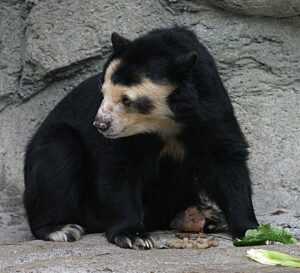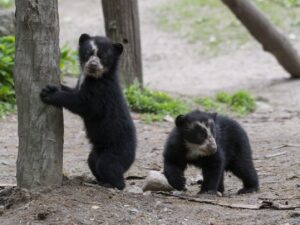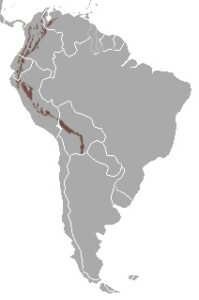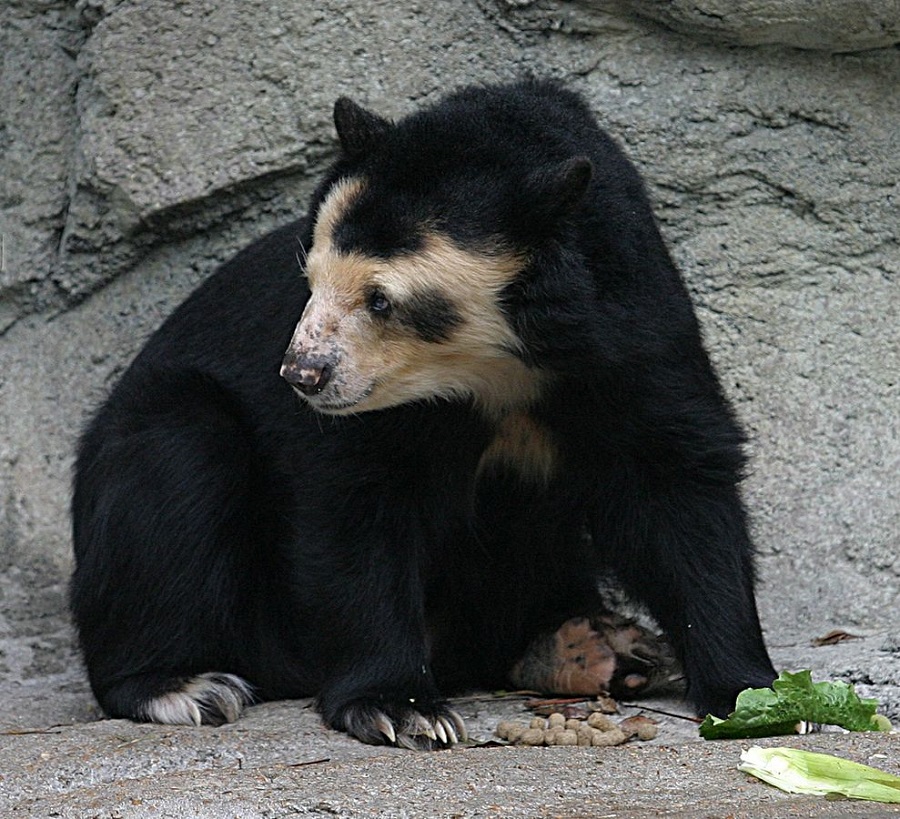Tremarctos ornatus (literally meaning decorated hole bear, referring to a hole in the bear’s humerus)
Spectacled Bear Facts
Spectacled bears are one of the smallest species of bear and the only living bears from South America. Despite its size, the spectacled bear is actually the largest land carnivore in that part of the continent, although only a small percentage of its diet is made up of meat.
They are also known as the Andean Bear and have black or brown fur with some individuals having a reddish hue to their coats. They have distinctive beige markings across their chest and around their eyes, hence they have the appearance of wearing spectacles! They have a rounded face and short snout.
These bears live for about 20 years on average and have front legs that are longer than their rear legs. This means they are excellent at climbing trees and indeed spend much of their time in the canopy.

Size
Spectacled bears are the second smallest bear after the Sun Bear with males weighing up to 175 Kg and growing to 1.5 metres in length. Females can be up to 50% smaller and rarely weigh more than 82 Kg.
Spectacled Bear Behaviour
Spectacled bears are generally nocturnal and are most active in the twilight of dawn and dusk. They spend much of their time up trees and are excellent climbers, even making their own feeding platforms up the trees which they use to rest on, store food, and concealment. They are generally solitary but are not territorial which means they are very quiet and they will avoid conflict with other bears where possible.
Are Spectacled Bears Dangerous?
These small bears are generally cautious and docile when faced with people and attacks are very rare. They will attempt to retreat by climbing trees when they encounter humans. That being said, like most bears they will try and defend themselves when they feel threatened and mother bears will protect their cubs if she thinks they are in danger. There is only one single reported human death from a spectacled bear encounter and this was a poacher who was killed after he shot the bear.
Spectacled bears do not have many natural predators. Cougars might attack cubs and they seem to avoid Jaguars but humans are by far their biggest danger.
Spectacled Bear Breeding
Spectacled bears can give birth any time of the year but mainly between April and June in order to synchronize to when the fruit ripens. Interestingly if the fruit crop fails the mother simply won’t give birth and can absorb the embryo back into her body. The gestation period is 6-7 months and mothers give birth to roughly 2 cubs every 2-3 years.
When they are born, Spectacled Bear cubs are blind, helpless, and weigh just 300 to 330 grams. On average two are born at the same time but there can be as few as one and as many as four. As the cubs grow they will travel around attached to their mothers at first and then will simply follow them everywhere. They will generally stay with their mothers for around a year, after which point they are chased away by male bears seeking to mate with the female.

Spectacled bear habitat
Spectacled bears live in the cloud forests of the Andes at an altitude of between 500 and 2,700 metres. They also live in the high Andean moorland called paramo. They migrate between the forests and paramos in search of ripe fruit and new leaves.
They live in a narrow band of land running from Venezuela to northern Argentina that includes Colombia, Ecuador, Peru, and Bolivia. They are more numerous on the Eastern side of the Andes as there is less human habitation there.

Diet
Spectacle Bears are omnivorous but are mostly vegetarian with meat only making up around 5% of their diet. They eat predominantly fruit, berries, honey and cacti but will also eat bromeliads, bamboo hearts, the soft parts of palm trees, and corn when fresh fruit is hard to come by. This plant-based diet is supplemented by insects such as ants and termites; birds and rodents. They are actually the second most “vegetarian” bear after the panda. They have even been observed sitting in trees on a platform made of branches for days, waiting for the fruit to ripen.
Conservation Status
Spectacled Bears are not endangered as such but are listed as vulnerable, one step down, by the International Union for Conservation of Nature. There are thought to be around 3,000 Spectacled bears left in the wild and unlike Pandas, for example, there is no huge push for conservation and their numbers are not recovering.
There are unfortunately several threats to these little bears with habitat loss probably being the most severe. It is thought that as little as 5% of their original habitat is now left and it is still being cleared for farming and logging. This clearance also means the bears are more often coming into closer contact with people and livestock which brings other problems.
As well as habitat loss, Spectacled bears also have to contend with poaching and hunting. Local farmers will often kill the bears as they suspect them of taking livestock. This may take place but most often the bears will just eat already dead animals that have been killed by other predators. The raiding of crops such as corn definitely does take place, however, and is more common as more of the bear’s habitat is cleared for farming. This brings them into conflict with the farmers and is the number one reason that they are killed by humans.
In addition, they are captured for the pet trade and hunted for their gall bladders, which are sadly still highly sought after in Chinese medicine. Trophy hunting was popular in the 19th Century but this threat has reduced in recent years.

Adaptations
As well as their front limbs being longer than their back legs, enabling them to easily climb trees, they also have long, curved claws that also help them climb. These claws are also very well adapted to digging into termite mounds and anthills. In addition, they have very strong jaws and wide, flat molars to help them chew through tough tree bark.
F.A.Qs
How many spectacled bears are left in the world?
There are only around 3,000 spectacled bears left in the wild and they are listed as vulnerable due to habitat loss and poaching by humans.
Do spectacled bears eat meat?
Yes, they do but not much. Only 5% of their diet is meat and only the panda bear more of a vegetarian in the bear world! They will sometimes eat small rodents and birds and will eat any dead animals they find.
Is Paddington bear a spectacled bear?
Yes, he is! Created by the author Michael Bond in 1958, Paddington is now a world-famous bear! He arrived at Paddington station from Peru dressed in a coat, a hat, and some boots and was taken in by a kind family who looked after him in London. There have been numerous books, cartoons, and merchandise and the films are completely charming. I can recommend that anyone with even a passing interest in bears checks them out as I absolutely love them!

